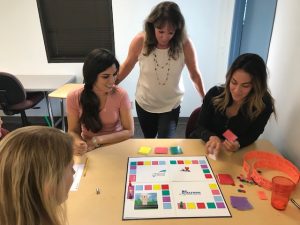
In this message, I offer an extended look at the work one of our colleagues has been doing with active learning in her classrooms. I hope some of you will share your experiences with similar types of approaches (either as a teacher or a student) by responding to this email or visiting our Joyful Teaching blog (by the way, because it has so many images and is rather long, this message may well be easier to read on the blog).
•••••••••••••••••••••••
Back in September, our colleague Marti Essman shared the following about her surgical nursing class:
“Hi Jim— just wanted to share that I do all active learning in my 8 week hybrid Medical-Surgical Course that starts in October. I have 4 learning stations that students rotate through and I am happy to allow any faculty member to come and observe. The feedback from students is consistently positive. They watch the lecture/PowerPoint prior to class and come prepared for the learning stations. Just thought I would share :-)”
Intrigued by this description, I asked Marti if I could drop by, observe for a bit, and share more about how she uses active learning in her classroom. I visited her class in mid-October when it was just beginning.
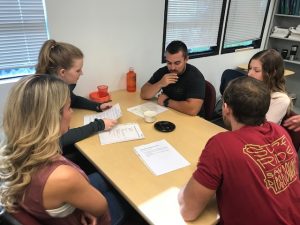
As Marti notes, the key to creating this kind of engaging, active learning environment is having students work through the material independently before they come to class: a technique pedagogical hipsters now like to refer to as a “flipped classroom.”
Marti deployed this active learning / flipped classroom model for the class I observed by providing a set of resources before class for the students to study: beginning with a lively and visually effective narrated powerpoint lecture (of about 40 minutes) accompanied by several different tools for taking notes about and studying / processing that lecture, and continuing on to a series of readings and other resources. (Note: the answers to the in class stations activities you see included on this image did not appear in Canvas until after the class meeting.)
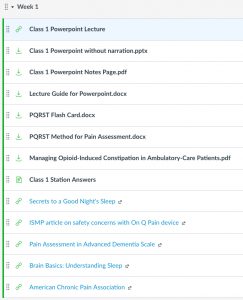
Students review these carefully sequenced materials before they come to class. When they arrive to the classroom, they encounter a meticulously prepared schedule for the day designed to maximize every minute of their weekly class meeting:
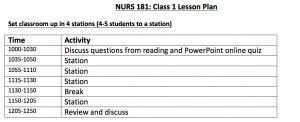
Instead of listening to the instructor review / lecture in front of the class or having a more traditional discussion experience, students are divided into small groups that rotate through a series of stations designed to actively engage the students in not only reviewing material but applying and clarifying it.
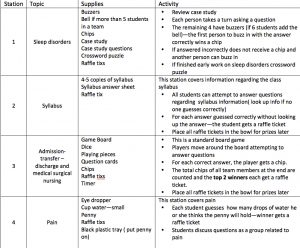
Marti also follows up carefully on the active learning activities with weekly surveys on the students’ experiences with them and content quizzes the students complete after they have participated in the active learning activities designed to help them review and master that content.
I must confess that I was a bit shocked and awed by the depth of Marti’s careful preparation for these activities. As I roamed from group to group, it was clear to me that the students were both enjoying themselves and learning much more than they would be if they were receiving information in a more passive mode.
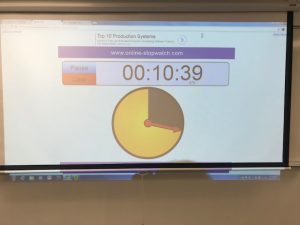
Again and again I was struck by little details that established a high level of commitment from the professor and an equally high level of focus and engagement from the students. From the “how could I not thought of this myself” use of a giant stop watch on the class screen to the painstaking detail Marti had put into creating the materials for each activity, right down to designing her own game board (complete with MCC logo !!).
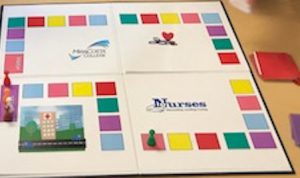
While this active learning narrative is undoubtedly a story of a gifted, creative, and committed instructor, it is also a story about the power of a sabbatical to enhance our passion for and knowledge of teaching and learning strategies and approaches. Last semester, Marti used her sabbatical to study active learning; much of what I saw in her classroom that day directly resulted from or was significantly enhanced by that sabbatical experience.
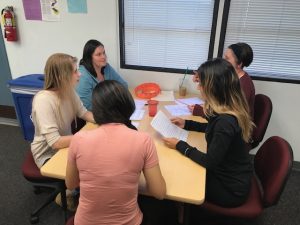
If you wish to explore some of these active learning resources more on your own, Marti has shared with me this list of some of the best of her sabbatical reading. Remember, time you spend reading these works is flex eligible under the “other approved activities” option in your flex transcript.
- Bean, J.C. (2001). Engaging ideas: The professor’s guide to integrating writing, critical thinking, and active learning in the classroom. San Francisco: Jossey-Bass Publishers
Burgess, D. (2012. - Teach like a pirate. San Diego, CA: Dave Burgess Consulting, Inc.
- Deck, M.L. (1995). Instant teaching tools for health care educators. St. Louis: Mosby, Inc.
- Deck, M.L. (2004). Instant teaching tools for the new millennium. St. Louis: Mosby, Inc.
- Nash, R. (2014). The active lassroom (2nd ed.). Thousand Oaks, CA: Corwin
Silberman, M. (1996). - Active Learning: 101 strategies to teach any subject. Boston: Allyn and Bacon
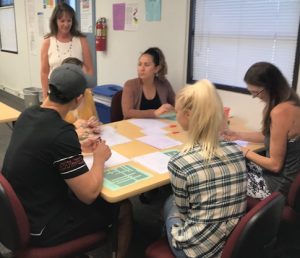
Many thanks to Marti for sharing her time, her classroom, her canvas site, and her resources with us. I hope some of you will take her up on her generous offer to welcome visitors to her classroom: messman@miracosta.edu
Although I doubt I will ever be organized enough to be the 100% active learning teacher Marti has become, I was inspired by what I saw in her classroom and have been using what I saw there (and reading about since) to re-imagine my classroom spaces (both onsite and online) and the kind of things I would like to see my students do within them.
I hope this look at Marti’s work will inspire you to share your strategies, ideas, and experiences either by responding to this email or visiting the Joyful Teaching blog.
Prepostero
PDP Coordinator
P3: Prince of Pedagogical Playfulness
Bringer of Joyful Tidings
the artist formerly known as gym sullivan
Hi Jim,
I just wanted to thank you for sending this message on a day when I am a bit stuck with lesson planning. It has already made me rethink my plan for today to make it more active.
Though I try to include active learning activities often, I also for some reason generally operate under the assumption that students should be doing roughly the same activity at the same time, even if I do include “stations” (which is rare). Today I think I’ll shatter my assumption.
Right now in my English 202 course, I am teaching a unit on “alternative rhetorics”: forms of rhetoric that receive less attention academically than verbal and written rhetoric. This week we are talking about procedural rhetoric, discussing how video games can make arguments about the real world. Today, students are supposed to play Papers, Please before class, a game that positions the player as a border agent in a fictional Soviet-style country in the 1980s. The game reflects on immigration policy and empathy. We were going to discuss the game for the first half of class, and look at sample student essays for the second half.
Instead, I think what I’ll do is create stations that utilize the classroom space to get students engaged at different levels at different times. One station, at the computer, will require students to read the sample essay (which is on Papers, Please) and use Microsoft Word to comment on it and grade it like I grade their papers. Another station will have students write reactions to Papers, Please on the board and use those reactions to collaborate on an essay introduction. Another station will ask students to brainstorm a design for their own rhetorical game using a specific prompt.
Since I haven’t tried this yet, I’m not sure how it will turn out, but I wanted to thank you and Marti for the inspiration today. While I also don’t know if I’ll ever be organized enough to provide so much up front on Canvas, I’m excited to implement this idea on a smaller scale.
Thanks!
I loved the photos and descriptions of Marti’s classroom. I also appreciated the resources list. I remember hearing Dave Burgess do his “Teach Like a Pirate” performance at the Active Learning Leaders (ALL) Teaching Conference at Palomar College which I presented at several years ago. He was inspiring! Unfortunately, not what I say often enough after encountering an educator. The next edition of that ALL is coming up January 28th. It’s a great flex activity. Check it out here:
http://www2.palomar.edu/pages/activelearning/
Oh, and for a very different example of our faculty using learning stations, read Lynne Miller’s recent GIFT.
http://www.miracosta.edu/studentservices/writingcenter/downloads/GIFTSMiller17.pdf
YES Denise–that is the conference that inspired me to do learning stations!!!
Thank-you Daniel—I am excited for you as you start incorporating more active learning 🙂